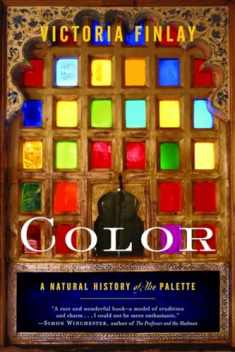
Bright Earth: Art and the Invention of Color
ISBN-13:
9780374116798
ISBN-10:
0374116792
Edition:
First Edition
Author:
Philip Ball
Publication date:
2002
Publisher:
Farrar, Straus and Giroux
Format:
Hardcover
384 pages
Category:
History
,
Arts History & Criticism
FREE US shipping
Book details
ISBN-13:
9780374116798
ISBN-10:
0374116792
Edition:
First Edition
Author:
Philip Ball
Publication date:
2002
Publisher:
Farrar, Straus and Giroux
Format:
Hardcover
384 pages
Category:
History
,
Arts History & Criticism
Summary
Bright Earth: Art and the Invention of Color (ISBN-13: 9780374116798 and ISBN-10: 0374116792), written by authors
Philip Ball, was published by Farrar, Straus and Giroux in 2002.
With an overall rating of 3.7 stars, it's a notable title among other
History
(Arts History & Criticism) books. You can easily purchase or rent Bright Earth: Art and the Invention of Color (Hardcover) from BooksRun,
along with many other new and used
History
books
and textbooks.
And, if you're looking to sell your copy, our current buyback offer is $0.82.
Description
A fascinating study of the evolution of color in art and science from antiquity to the present.
For art in the twentieth century, medium is the message. Many artists offer works defined by their materials. In no aspect is this more strikingly demonstrated than in the use of color.
Bright Earth is the story of how color evolved and was produced for artistic and commercial use. The modern chemical industry was spawned and nurtured largely by the demand for color as many of today's major chemical companies began as manufacturers of aniline dye; advances in synthetic chemistry, both organic and inorganic, were stimulated in the nineteenth century by the quest for artificial colors. The future holds still more challenges for the color chemist, not only to provide new coloring materials, but also to replace old ones that will shortly become extinct, as concerns about the use of lead and cadmium pigments increase.
In Bright Earth, Philip Ball brings together the themes of art and science to show that chemical technology and the use of color in art have always existed in a symbiotic relationship that has shaped both their courses throughout history. By tracing their co-evolution, Ball reveals how art is more of a science, and science more of an art, than is commonly appreciated on either side of the fence.


We would LOVE it if you could help us and other readers by reviewing the book
Book review

Congratulations! We have received your book review.
{user}
{createdAt}
by {truncated_author}




